Poly(3-hydroxybutyrate) resin sheet for thermoforming, molded body formed from the sheet, and methods for producing the sheet and molded body
a technology of polyhydroxybutyrate and resin sheet, which is applied in the field of poly(3-hydroxybutyrate) resin sheet for thermoforming, and the method of producing the sheet and the molded body, can solve the problems of environmental problems caused by waste plastics, the inability to quickly degrade plastics in the actual oceans, and the creatures ingested plastics suffer, etc., to achieve quick degradability, good appearance, and uniform thickness
- Summary
- Abstract
- Description
- Claims
- Application Information
AI Technical Summary
Benefits of technology
Problems solved by technology
Method used
Image
Examples
example 1
[0075]A T-die with a width of 500 mm was coupled to a single-screw extruder having a screw diameter of 40 mm, and the cylinder and die temperatures of the extruder were set to 160° C. The resin pellets 1 were placed into the extruder and extruded into a sheet shape. The extrudate was held between two cooling rolls located below the T-die, and the edges of the extrudate in the width direction were slit to give a sheet having a width of 310 mm and a thickness of 0.31 mm. In the evaluation of the thermoformability of the sheet, the sheet was preheated to a preheating temperature of 140° C. and subjected to thermoforming using a square frame 300 mm on a side. The evaluation result is shown in Table 2.
example 2
[0076]A sheet was obtained and evaluated for thermoformability in the same manner as in Example 1, except that the resin pellets used for the processing were changed to the resin pellets 2. The evaluation result is shown in Table 2.
example 3
[0077]A sheet was obtained and evaluated for thermoformability in the same manner as in Example 2, except that the sheet thickness was 0.16 mm. The evaluation result is shown in Table 2.
PUM
| Property | Measurement | Unit |
|---|---|---|
| melting point | aaaaa | aaaaa |
| thickness | aaaaa | aaaaa |
| melt viscosity | aaaaa | aaaaa |
Abstract
Description
Claims
Application Information
 Login to View More
Login to View More - R&D
- Intellectual Property
- Life Sciences
- Materials
- Tech Scout
- Unparalleled Data Quality
- Higher Quality Content
- 60% Fewer Hallucinations
Browse by: Latest US Patents, China's latest patents, Technical Efficacy Thesaurus, Application Domain, Technology Topic, Popular Technical Reports.
© 2025 PatSnap. All rights reserved.Legal|Privacy policy|Modern Slavery Act Transparency Statement|Sitemap|About US| Contact US: help@patsnap.com

